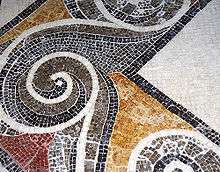San Pawl Milqi
 Roman remains at San Pawl Milqi | |
| Location | Bumarrad, Malta |
|---|---|
| Type | Roman villa |
| Website | www.heritagemalta.org |
San Pawl Milqi is the ruin of a Roman-period agricultural villa, the most extensive to have ever been unearthed in Malta.
According to tradition the villa is where St. Publius, the governor and first bishop of Malta, welcomed St. Paul after his shipwreck in 60AD. However, there is no archaeological evidence that Publius ever lived in the villa. In fact, evidence of Christian worship on the site only dates back to the building of the first chapel in the fourteenth century.
On site there was a temple dedicated to the Greek God Apollo and a Roman villa close to the Chapel of St. Paid el Milki (San Pawl Milqi).[1]
It is managed by Heritage Malta and closed for conservation except for the annual open day, which is usually in February.
History
The site has been in use since prehistoric times; a couple of tombs date back to the Zebbug and possibly the Borg in-Nadur phases of the Maltese Bronze Age.
The first building on the site was probably built in the Phoenician-Punic period, when the site was used intermittently for agriculture. A small number of structures remain from this period and one burial bears a neo-Punic inscription.
In the Roman period, the site’s position on the slopes of a fertile valley and vicinity to the Roman harbour at Salina meant that it was ideally suited to the production of olive oil. The establishment was expanded; the original central courtyard was transformed into an industrial area. The trapetum (a rotating mill used to separate pips from olive fruit), anchor points and at least two presses can still be seen, as well as a set of settling vats used to purify oil.
Although large enough to have been the property of a rich aristocrat, the villa does not contain any residential quarters of any particular richness. The four rooms which can be identified as serving residential needs were, in fact, only decorated with painted wall plasters and common cocciopesto flooring. None show the elaborate and expensive floor mosaics like those of the Domvs Romana in Rabat.
The site was eventually reduced in size and surrounded by a thick fortification wall, probably during the period of Arab rule in Malta. Its fortified walls, constant water supply and good position meant that it was ideally located to control the nearby port and valleys.
A church was built on part of the site in the fourteenth century, but after more than a century it fell into disuse and in 1616 was replaced by a church dedicated to the welcoming of St. Paul. This church, which still stands today, is the oldest record connecting the site to the traditional event.
Excavation
Although the remains of the villa have long been well known, scientific excavations, led by the Missione Archeologica Italiana a Malta, did not commence until 1963. The final report on these excavations is yet to be published.
The site was included on the Antiquities List of 1925.[2]
References
External links
Coordinates: 35°56′08″N 14°24′47″E / 35.9355°N 14.4131°E
